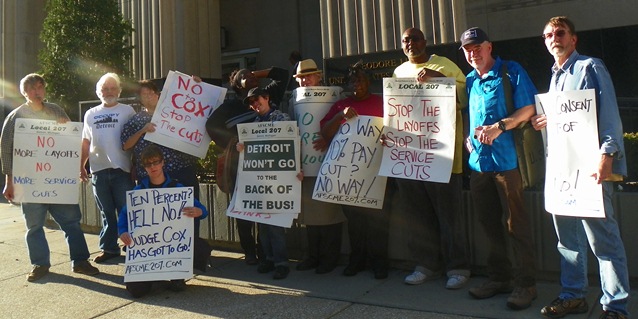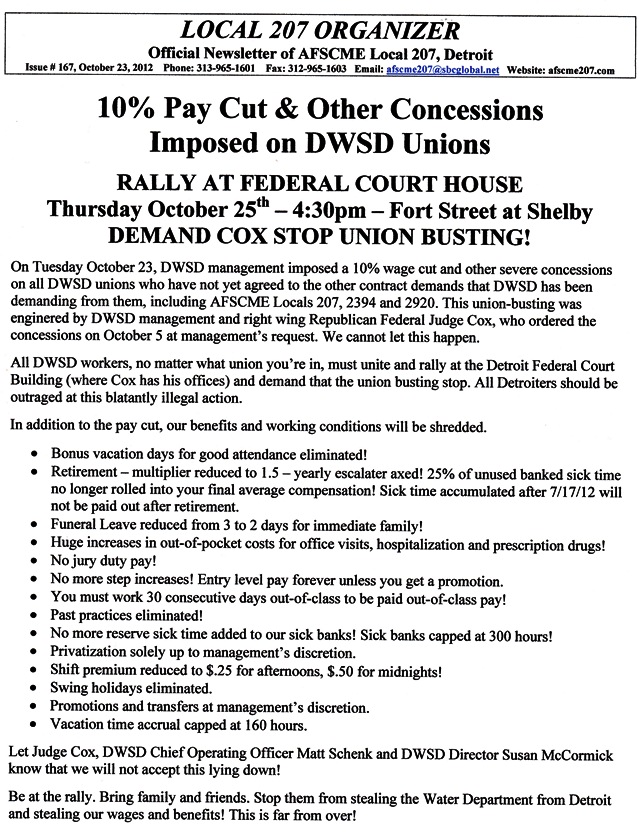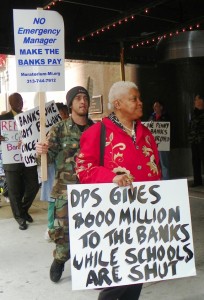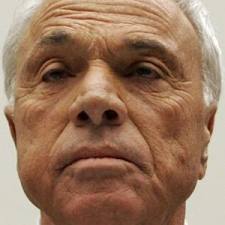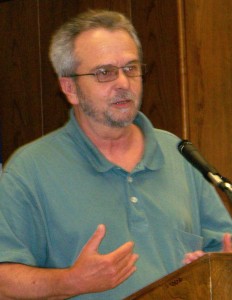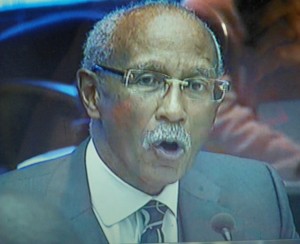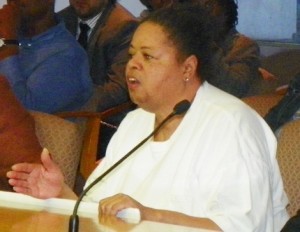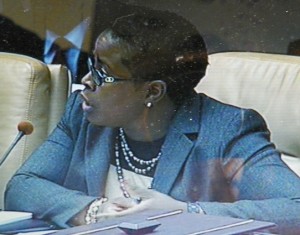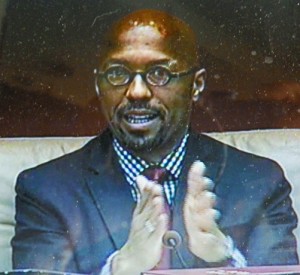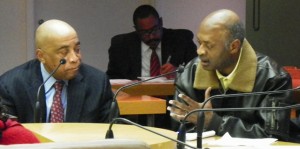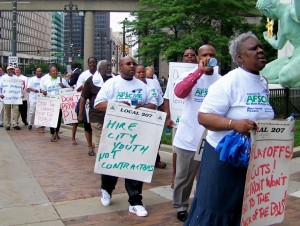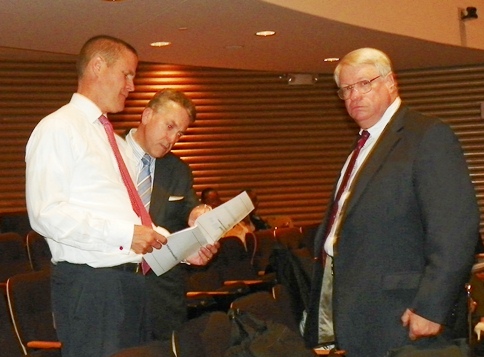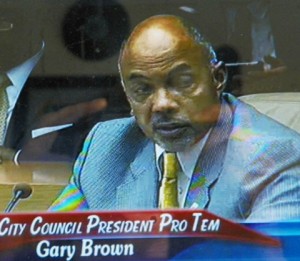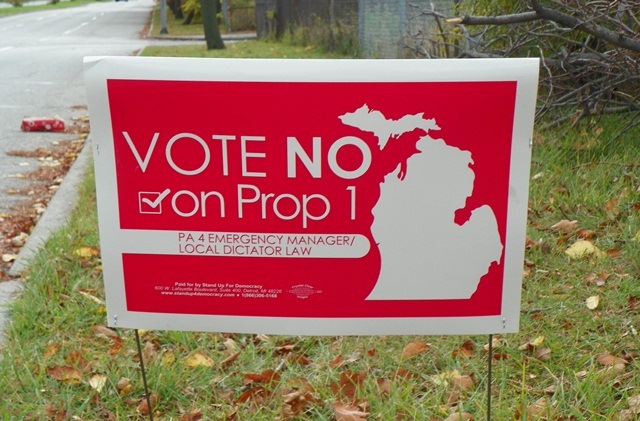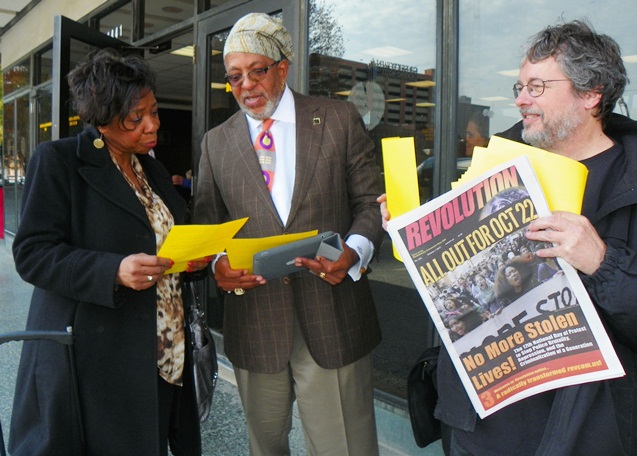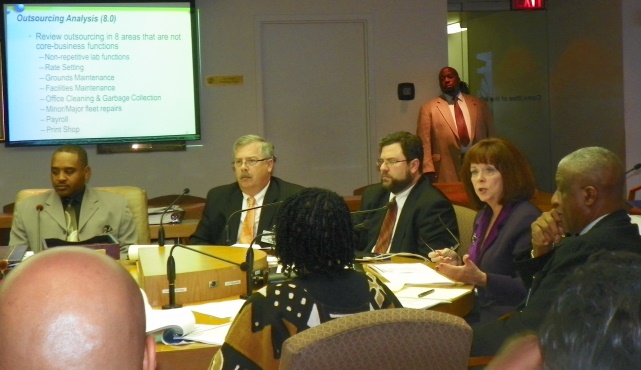
- DWSD director Sue McCormick, speaking, and (l to r) BOWC financial advisor Butler Benton, Chair Walter Fausone, DWSD COO Matthew Sheck, BOWC V-P James Thrower, and BOWC member Mary Blackmon push for Council approval of $48 million EMA down-sizing contract Oct. 15, 2012.
- Oct. 15 order follows week-long water workers’ strike
- Council member Brown pushes for passage by Oct. 23 anyway
- EMA would cut up to 81 percent of DWSD workforce
By Diane Bukowski
October 19, 2012
DETROIT – In the wake of a week-long strike by Detroit Wastewater Treatment Plant workers, the U.S. government on Oct. 12 barred any action for 45 days on a five-year $48 million city contract with the EMA Group. In a filing before U.S. District Court Judge Sean Cox, the federal Environmental Protection Agency (EPA) said it wants to review the contract’s impact on the city’s compliance with the Clean Water Act (CWA).
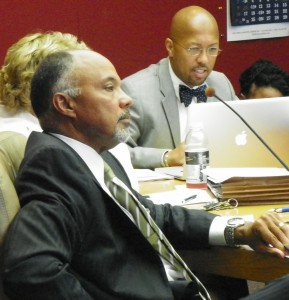
- Council Pres. Pro-tem Gary Brown and Pres. Charles Pugh in session Sept. 13, 2011. They both served on Judge Sean Cox’s secret “Root Case” committee to re-structure DWSD and hand control to non-Detroit interests.
EMA plans to cut 81 percent of the Detroit Water and Sewerage Department (DWSD) workforce. City Council President Pro-Tem Gary Brown, DWSD leaders, and members of the Board of Water Commissioners pressed for its passage at a Council committee meeting Oct. 15 despite the EPA filing.
“We intend to get this contract out of committee and in front of the Committee of the Whole as soon as humanly possible,” Brown said. “It should be doable in 8-10 days.”
The U.S. government maintained that there is no urgency to implement the contract because the DWSD is not currently in violation of CWA provisions. It said the Michigan Department of Environmental Quality (MDEQ) just made it aware of the proposed contract. (Click on EPA intervention DWSD case https___ecf.mied.uscourts.gov_cgi-bin_show_temp.pl_file=5195023-0–13077.)
 “EPA seeks a period of forty-five (45) days to evaluate the potential impacts of the proposal on CWA compliance and asks this Court not to take any actions that would open the way for DWSD to initiate implementation of the proposal prior to that time,” U.S. attorney Annette Lang wrote.
“EPA seeks a period of forty-five (45) days to evaluate the potential impacts of the proposal on CWA compliance and asks this Court not to take any actions that would open the way for DWSD to initiate implementation of the proposal prior to that time,” U.S. attorney Annette Lang wrote.
“DWSD has not reported any violations of its NPDES numeric limitations on solids since November 2011 and has not reported any other NPDES numeric effluent limitation violations since March of this year. Therefore, nothing in the record would indicate that immediate commencement of the implementation of the proposal is required.”

- U.S. District Court Judge Sean Cox
She said that the EPA was not taking a position on the contract yet, but would meet with MDEQ and DWSD representatives for review, beginning Oct. 16.
The federal consent agreement, under which Cox has issued several anti-union, ant-Detroit orders, was initiated by the U.S. in 1977. It is known as U.S. vs. City of Detroit et al, Case No. 77-71100.
Attorney Peter Cavanaugh commented on his firm’s blog, Digesting DWSD, “The case that Judge Cox currently presides over was originally filed in 1977 by the U. S. Environmental Protection Agency to enforce compliance with the Clean Water Act. The EPA has not played an active role in the case, however, for a number of years. The EPA’s request that Judge Cox ‘take no action’ for 45 days is an interesting development. Judge Cox is not bound to comply with the EPA’s request, but it is unlikely that he would simply ignore it.” http://dwsdupdate.blogspot.com/
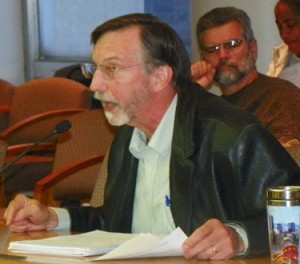
- Local 207 Secretary-Treasurer Mike Mulholland at Council meeting Oct. 15, 2012.
During the Oct. 15 meeting of the Council Public Health and Safety Committee, which Brown heads, AFSCME Local 207 Secretary-Treasurer Mike Mulholland and President John Riehl lambasted him for pressing for Council passage of the EMA contract. The BOWC approved it Sept.7, but Council approval is still needed because the City itself is letting the contract, and because of the size of the contract.
Brown and Council President Charles Pugh were members of a secret “Root Cause Committee” appointed by Cox last year to consider proposals on re-structuring DWSD governance. Cox issued a gag order on all members of the Committee, even barring Brown and Pugh from discussing its proceedings with their Council colleagues.
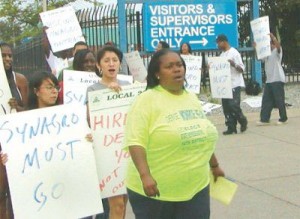
- Local 207 and community members including Denise Hearns (front) protested Synagro contract in front of WWTP in 2008.
“The Sixth Circuit just heard our appeal of Judge Cox’s Nov. 4, 2011 order,” Mulholland said. “You want the Council signed on to this plan which is predicated on an illegal order from a right-wing Republican federal judge. It’s like having the Tea Party here. This is an attack on organized labor and our living standards. We also have an obligation to protect the environment for our children and grandchildren. The EMA proposal bypassed the bidding process and is inherently corrupt, recalling the contracts with Minergy and Synagro which led to the current public corruption trials of Kwame Kilpatrick and [former DWSD head] Victor Mercado.”
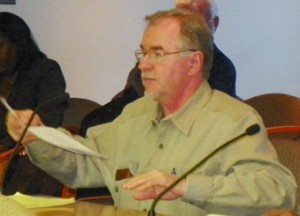
- AFSCME Local 207 President John Riehl tells Council that EPA has intervened in EMA contract dealings Oct. 15, 2012.
Riehl said, “The EMA contract doesn’t solve any Clean Water Act problems. Business Week just published an article, ‘Detroit Shows Wall Street Never Loses on Bad Swaps,’ which talks about how the banks are profiting from DWSD debt. DWSD’s motion was opposed by the City of Detroit Law Department and the EPA is challenging it, asking Judge Cox to restrict any action. The Cincinnati hearing went well, and may possibly invalidate Cox’s order re-structuring the department.”

- Judge Boggs
The hearing on the appeal of Cox’s Nov. 4, 2011 order was held Oct. 9, 2012 in front of a three member panel consisting of Appeals Judges Danny Boggs, an active Republican and Reagan administration appointee, Eric Clay, a Clinton administration appointee who clerked for retired Sixth Circuit Court Judge Damon Keith and c0-founder of the noted Black-owned Detroit law firm Lewis, White and Clay, and William Stafford, appointed by former President Gerald Ford to the U.S. District Court of Florida, Northern District.

- Judge Clay
Appellants AFSCME Council 25, AFSCME Local 207 and the Senior Accountants, Analysts and Appraisers Association (SAAA) were represented by attorneys Herbert Sanders and George Washington. (VOD will publish audio recording when it becomes available.)
Russ Bellant said he worked at DWSD previously as a water plant operator and later in its skilled trades development division, which sought to recruit Detroiters and workers of color.
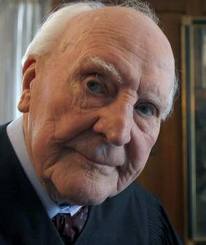
- U.S. District Court Judge John Feikens, who previously oversaw the Detroit sewage side of the EPA lawsuit, before his retirement.
“The problem with this flawed proposal is that it is predicated on an overreach of the power of the federal court,” Bellant told the Council members. “The consent agreement only involves the wastewater side of the department, not the freshwater side. But previously [U.S. District Court Judge] Feikens and Mayor Kilpatrick broadened it to allow the Mayor to do no-bid contracts. A $150 million no-bid contract for water meter replacement was one of them, let without council approval. Ratepayers will be paying $22 a year per household for the next 30 years to finance this. The City Council itself needs to take Sean Cox to the appeals court, because his rulings are imposing devastating consequences on our city.”
DWSD Director Sue McCormick presented a slide show on the EMA contract and painted the company in glowing terms during the committee session.
She said DWSD used to have a staff of over 5,000 but now has only 1,978 workers. The EMA proposal will further slash 1,828 positions over a 5-year period, including 262 vacant positions. The cuts would leave 362 positions, for a savings of $136.9 million over five years, or about $27 million a year. DWSD currently has a combined annual budget of $932.4 million. (See slide below.)
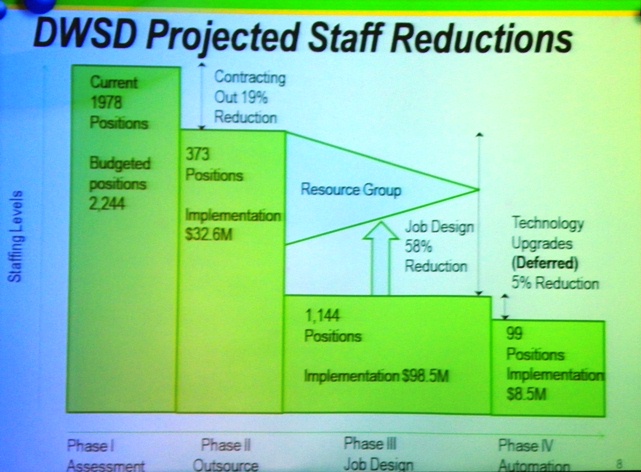 DWSD is the third largest water and sewerage system in the U.S. It provides water for 40 percent of the state of Michigan’s population, over 1,079 square miles including Detroit and six surrounding counties, and wastewater service over 946 square miles. (See DWSD website at http://www.dwsd.org .)
DWSD is the third largest water and sewerage system in the U.S. It provides water for 40 percent of the state of Michigan’s population, over 1,079 square miles including Detroit and six surrounding counties, and wastewater service over 946 square miles. (See DWSD website at http://www.dwsd.org .)
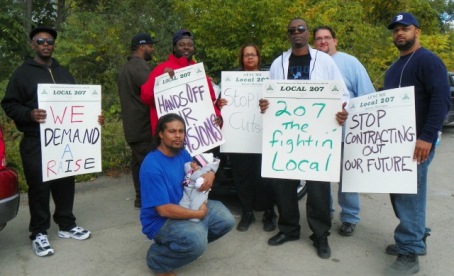
Wastewater Treatment Plant workers on strike Sept. 30, 2012 demand an end to contracting out.
“I spoke to hundreds of employees,” McCormick said. “The system is broken. We need to outsource non-core services like janitorial and lawn work and invest in new technology.” She said the new technology would include new IT systems and automation of human-powered functions.
“There needs to be a cultural change,” McCormick said, “because workers don’t have broad enough knowledge of the entire process. We need to empower the employees by broad-banding jobs. This is required by the court order.”
The EMA plan involves compacting 257 classifications into 31 classifications, with the drastically-slashed number of workers cross-trained in other titles.
McCormick said the cutbacks are critical to maintaining affordable rates for customers. However, no rate caps are included in the contract, she said, only “good intentions.”
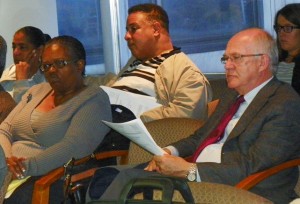
- EMA VP Brian Hurding (r) sat in audience during Council session Oct. 15, 2012 listening to EMA contract presentation. AFSCME Co. 25 staff rep. Catherine Phillips is at left.
As VOD noted earlier, a prominent municipal bond management firm told the BOWC on Aug. 29 that in fact customers must be prepared for more rate increases. Siebert, Brandford, Shank & Co. (SBS) said that to “enhance DWSD credit,” primary goals must include “educating the public about [infrastructure] projects and the need for water and sewer rate increases.”
McCormick lauded EMA, as its representative Brian Hurding sat in the audience. He did not speak during the session. She said there was no reason to put the proposal out for bid.
“Their process is unique in the business,” she said. “No one does what they do.”
She added that there was no time to issue a Request for Proposal (RFP), claiming the process would have put DWSD “10 months back,” and made it unable to respond quickly to Cox’s orders.
Members of the Board of Water Commissioners said they performed “due diligence” by having staff members call cities where EMA has performed before.

______________________________________________________________
BOWC members present at the session were Chair Walter Fausone, Vice-Chair James Thrower, and Mary Blackmon. Also present from DWSD were its COO Matthew Schenck, Financial Advisor Butler Benton, and others.
“We made sure we did our due diligence before approving EMA,” Thrower said. “We have bankers, engineers, financiers and those with utility experience on the board and its staff. We called other cities EMA has been with.”

- Councilwoman Brenda Jones at Oct. 15 committee meeting.
Asked by Councilwoman Brenda Jones whether EMA has experienced any failures in the other cities, McCormick said, “There was a problem in Toronto with subway flooding this year. There was a contractor responsible for diversion of sanitary sewage in the path of subway construction. During the course of construction, the contractor experienced two different rainfall events. The flooding was totally not due to EMA work.”
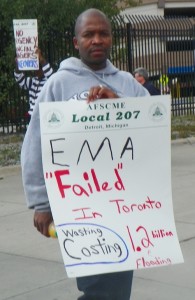
- Wastewater Treatment Plant worker during Sept. 30, 2012 week-long strike.
VOD earlier reported that Toronto newspaper articles showed that floods there, resulting from sewage back-ups, have involved not only the subways, but homes and streets in neighborhoods throughout the city during most of the last decade. EMA began work in Toronto in 1995, and in 2001 instituted a drastic reduction in workforces at its sewage plants. (http://voiceofdetroit.net/2012/08/22/toronto-under-water-sewage-in-wake-of-ema-plan/.)
McCormick and Fausone also said there had been problems in Akron, Ohio and Minneapolis, Minnesota, but that they were not EMA’s fault. McCormick claimed EMA has a success rate of 90 percent, but did not document that. She said a “book” of documentation was earlier provided to council staff and to its Research and Analysis division.
DWSD and BOWC representatives said EMA itself will issue Requests for Proposals for private contracts and select the contractors, although McCormick claimed DWSD was not handing over its operations to EMA.

Youth supporting Local 207 protest at WWTP July 24, 2012 point out listing of huge contracts on WWTP walls, just a sampling of private contracts DWSD lets.
Blackmon claimed that a commitment to use “Detroit-based businesses” is in the EMA contract, but did not produce the paperwork. McCormick said there has been no study yet of what Detroit businesses are available for DWSD contracts.

- This business is Detroit-headquartered, Detroit-based and minority-owned.
Brown said the problem with the Bobby Ferguson contract in the Kilpatrick administration was that the city at the time required “Detroit-headquartered” businesses, which he does not advocate.
“The part of the city program requiring headquarters-based businesses getting 30 percent of the contracts should not have been in there,” he said. “That was a bad policy for years that probably led to corruption.”
According to a previous Human Rights Department worker, however, that classification was established because many national and international corporations were opening front offices in Detroit in order to qualify as “Detroit-based” businesses, even though they could compete for 70 percent of city contracts without that designation.
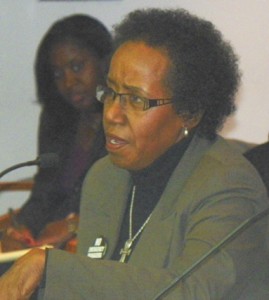
APTE’s Cecily McClellan speaks at council committee meeting on EMA contract Oct. 15, 2012.
Councilwoman Jones asked if there is any guarantee in the EMA contract that there will be no “change orders” increasing its costs to the city.
Fausone said, “The Board is not in favor of change orders,” but McCormick said that is governed by orders from Judge Cox.
Others who spoke during public comment in addition to Riehl, Mulholland and Bellant t0 oppose the EMA contract were Chris Griffiths of Free Detroit-No Consent, Association of Professional and Technical Employees (APTE) Vice-President Cecily McClellan, and Tia Lebherz of the international organization Food and Water Watch.
McClellan, who saw an earlier presentation McCormick gave to Council staff, said the presentation given at the committee hearing was not complete.
“This presentation was smoke and mirrors,” McClellan said. “They left out their contentions about the DWSD debt and its supposed deficit. They claimed DWSD has a 40 percent level of debt while Toronto has a 20 percent level. DWSD is not in deficit. By charter, it cannot be in deficit.”
The last Comprehensive Annual Financial Report (CAFR), for 2011, posted by the city backed up McClellan’s contention that DWSD has no deficit. See postings of city CAFR’s at http://www.detroitmi.gov/Departments/Finance/tabid/86/Default.aspx .
The slide below shows the timeline EMA and DWSD want for their drastic re-structuring.
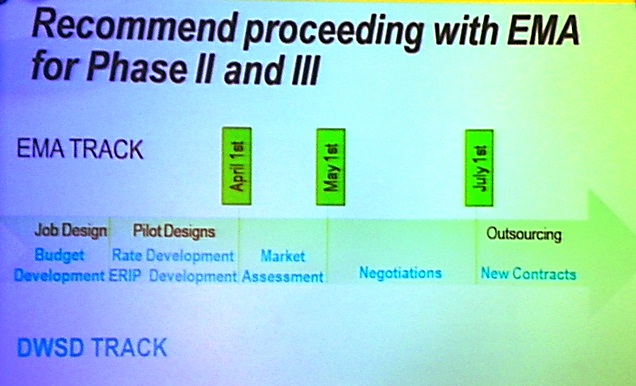
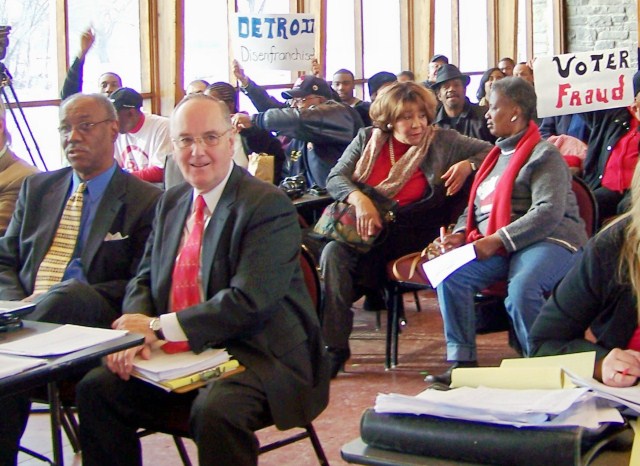
 Sat. November 3, 2012; 2:00 PM to 5:00 PM
Sat. November 3, 2012; 2:00 PM to 5:00 PM 


